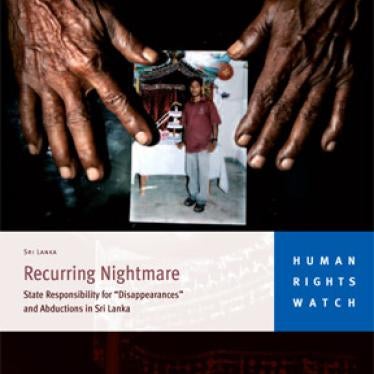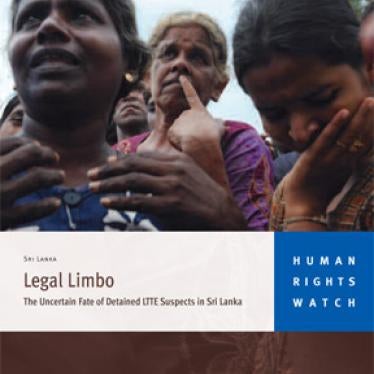(New York) - The Sri Lankan government should account for everyone who was taken into custody at the end of Sri Lanka's 26-year-long armed conflict in May 2009 and are feared to have been "disappeared," Human Rights Watch said today. Despite numerous requests from families for information about their relatives, the authorities do not appear to have conducted any serious investigations, Human Rights Watch said.
Human Rights Watch said unresolved enforced disappearances should be part of the mandate of a proposed United Nations investigation into laws-of-war violations by both government forces and the Liberation Tigers of Tamil Eelam (LTTE). A Panel of Experts appointed by United Nations Secretary-General Ban Ki-moon to advise him on steps for ensuring accountability for laws-of-war violations in Sri Lanka is expected to hand over its report later in April 2011.
"The Sri Lankan government needs to respond to all allegations of disappearances with more than a ritual blanket denial," said Brad Adams, Asia director at Human Rights Watch. "Family members of the disappeared have the right to know if their loved ones are alive or dead."
Through interviews with relatives of the missing and witnesses, published testimony, and media reports, Human Rights Watch found that more than 20 people who were taken into army custody between May 16 and 18, 2009, appear to have been forcibly disappeared. Most of them are known to have been detained in the Vadduvaakal area, just south of the strip of land in northeastern Sri Lanka where the final battle between the LTTE and government forces occurred. At the time, the area was controlled by the Sri Lankan army's 59 Division.
Under international law, an enforced disappearance occurs when the authorities take an individual into custody but refuse to acknowledge doing so or do not provide information about the person's whereabouts or fate. Among the rights an enforced disappearance may violate are those to life, liberty, and security of the person, including protection from torture and other ill-treatment.
The people believed to have been forcibly disappeared were detained at various times. About half the people involved in the cases documented by Human Rights Watch were detained when dozens of LTTE members surrendered to the army together with the Rev. Francis Joseph, a Catholic priest, south of the Vadduvaakal bridge on May 18. "Aananthi" (not her real name), the wife of one of the disappeared, told Human Rights Watch that she saw the army load the priest and the LTTE members onto a bus and drive them away. Human Rights Watch interviews with other witnesses and numerous media reports confirm her account. The wife and two children, ages 3 and 5, of an LTTE member were also taken away on the bus. The family members and Joseph remain missing.
Aananthi told Human Rights Watch that she has had no news about her husband since:
I have searched in all the camps. I went to the Defense Ministry. I filed a complaint with the police in January 2010. But I have received no information about my husband. The police only told me that it would be difficult for them to find him since the area where he went missing is under military control. I want the government to tell me what happened to him. Whether he is dead or alive, I want an answer.
Asked specifically about Yogiratnam Yogi, one of the men taken away on the bus, the Sri Lankan commissioner general for rehabilitation said in July 2010 that he was not among more than 11,600 LTTE cadres in custody. Human Rights Watch has established the names of several other people who were taken away on the same bus, but it has not been possible to confirm whether they remain missing.
In another disappearance case, a witness told Human Rights Watch that two former LTTE members helped government soldiers identify Colonel Ramesh, an LTTE leader, among the fleeing population and took him and three others away to a small hut nearby. Ramesh's family has not received any news about him since he was detained. In December 2010 several media outlets broadcast a video clip obtained by the Global Tamil Forum that allegedly showed Ramesh in custody.
Human Rights Watch has obtained several additional, longer videos of Ramesh, providing further evidence that he was in army custody. In one of the videos, Ramesh is seen lying on a bench in civilian clothes. In four other videos, several soldiers stand around Ramesh while one of the soldiers questions him about where he is from, the whereabouts of the wife of LTTE leader Velupillai Prabhakaran, and how he received an injury on his back. At one point it seems that the soldiers are telling Ramesh that the date is the 22nd, suggesting that the video may have been filmed on May 22, 2009. A sixth video shows only Ramesh answering questions about when he joined the LTTE, what his position is, and his family members.
A Sri Lankan military spokesperson dismissed the December video as fake and claimed that Ramesh had been killed during the last days of the war.
On May 17, army soldiers detained Paramnantham Kokulakrishnan and two other men just north of the Vadduvaakal bridge. Kokulakrishnan's wife told Human Rights Watch that the soldiers did not allow her to accompany her husband even though he was blind from an injury that he had received in 1996. The soldiers told her that they would interrogate the men and then release them, but she has not had any news of her husband since. Kokulakrishnan's family filed a complaint with the police in October 2010. The police replied in a letter that they would investigate the disappearance, but the family has received no information.
Another witness told Human Rights Watch that five people are still missing after they were separated from the rest on May 17 just south of the Vadduvaakal bridge. Among the missing is Sudarsani Krishnakumar. Her family has filed complaints with the national human rights commission and the police, but has received no information about her whereabouts.
In several cases, family members also testified before or filed written complaints with the government Lessons Learnt and Reconciliation Commission (LLRC), which was created by President Mahinda Rajapaksa in May 2010. While the commission has published testimony of government officials and others on its website, it has not published many of the testimonies alleging enforced disappearances by government forces.
The enforced disappearances took place as tens of thousands of people fled the war zone during the last days of the conflict. Government forces registered and screened the fleeing population, separating suspected LTTE members from the others. While family members have been able to locate many of the detainees in prisons or in so-called rehabilitation centers, some are still missing. In its February 2010 report "Legal Limbo: The Uncertain Fate of Detained LTTE Suspects in Sri Lanka," Human Rights Watch documented the government's lack of transparency in the screening and registration process.
Human Rights Watch called on the Sri Lankan government to investigate each reported case of enforced disappearances until the fate or whereabouts of the person is clearly and publicly established. The government should prosecute all those implicated in enforced disappearances, including civilian officials and military officers responsible as a matter of command responsibility.
The government should promptly extend an invitation and schedule a visit for the UN Working Group on Enforced and Involuntary Disappearances. The government should also sign and ratify the International Convention against Enforced Disappearance and enact national legislation that gives force to its provisions.
"The Sri Lankan government's stonewalling on accountability since the end of the war may be most tragic for those whose relatives are missing and feared disappeared," Adams said. "The government needs to say what has happened to these people and ensure that there are no more cases."








